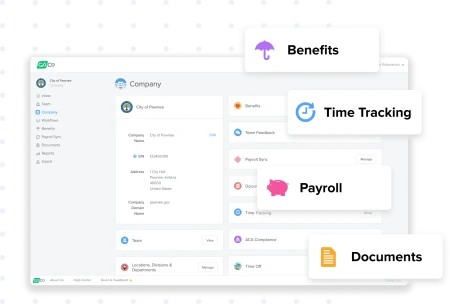Everything Your HR Team Needs to Know about PTO in 2024
Types of PTO structures, types of leave, PTO policies, and more
by Nick Schurk - December 21st, 2023
PTO is top of mind for your employees in 2024. The importance of offering paid time off goes beyond just providing employees with more days for vacation. It is about acknowledging the importance of work-life balance and helping employees prioritize their well-being.

PTO is one of the most desirable benefits an employer can offer – but it comes in many forms, such as sick leave, parental leave, and Family and Medical Leave Act (FMLA). Knowing what policy works best for your business can make it difficult. In this post, we will delve into the different types of PTO and its benefits, the best practices for managing it, and what the future of PTO expectations will look like.
What is PTO?
PTO is paid time off that often comes in a bundled set of days per year. Most companies allow you to accrue it over time, typically a set number of hours or days per pay period, and then request or use it when needed.
Some businesses choose to differentiate between types, such as:
Sick leave
FMLA
Parental leave
Volunteer time off (VTO)
Sabbatical leave.
Each provides valuable flexibility and can represent a substantial benefit to the employees.
There's no one approach – businesses determine which system works best for them. Some companies offer PTO as a bundle, others opt for the traditional unbundled leave policy, while others provide unlimited PTO policies.
However, most PTO policies give employees 10-14 days in addition to company-observed holidays. Small businesses often have to plan carefully as the less structured options can leave them potentially too short-staffed for the company to function if everyone takes the same days. In these businesses, it's common for people to rotate key vacation days (e.g., Christmas) or sign up / reserve vacation days well in advance so that people can plan coverage.
It's also up to the business to decide whether PTO can roll over to the following year. While many employees like the rollover option as it can allow them to take off for a month or longer with careful planning, it can also be a good practice to encourage regular downtime by encouraging annual vacations. We discuss this more in our article on PTO balances and encouraging employees to step away from the office.

What types of paid leave are there?
As we reflect on the importance of work-life balance, it's mind-boggling to think that some companies still don't offer paid leave options for their employees. Whether it's managing a short-term illness or tending to a new family member, time off is crucial for the well-being of workers.
A little empathy goes a long way in showing a company truly values its team members. If companies can afford luxurious office spaces, catered lunches, and team-building exercises, why not prioritize providing paid leave options?
Sick Leave
It's highly recommended that employers offer paid sick leave for employees to prevent the spread of illness. It's better to pay sick team members to stay home than force them into a situation where they might infect customers or coworkers. This can be included as part of the overall PTO policy or its own "bank" of time.
Medical Leave
The Family Medical Leave Act (FMLA) requires employers to offer 12 weeks of job-protected leave – typically unpaid and extends to the employees, their dependents, and the people they care for. Leave is often taken under the FMLA for:
Serious health conditions
Caring for a newborn baby
Caring for an adopted or foster child
Taking care of a family member with a severe health condition
Pregnancy
Bereavement:
This policy is generally reserved for when an employee experiences the loss of someone close to them and needs time for grief and arrangements.
Maternity and Paternity Leave:
Parental leave is often included as part of PTO, ideally covering people of all genders who are expanding their families through birth or adoption. Several states, like California, New York, and Rhode Island, require paid family leave.

What are the benefits of PTO policies?
Do you ever feel guilty for taking time off work to relax or care for personal matters? Chances are your employees do too. Taking time off to unwind and recharge can significantly benefit one's mental and physical health, ultimately leading to happier and more productive employees. Rested and happy workers bring the following benefits to their teams.
More flexibility
Employees don't have to lie or give excuses for why they need time off – like proving that they're physically ill when they just need a mental health day, for example. This gives them more autonomy and communicates mutual trust between themselves and the business.
Less absenteeism
When employees want to take time off but are forced to use specific forms of leave that don't fit their situation (like sick leave when they want to go to a concert), they'll have no choice but to take off work at the last minute. Without this barrier, they can plan their absences, which is better for the business.
Better health
When employees can take a vacation and mental health days as they see fit or visit the doctor's office for preventative reasons without people questioning their health, they're more likely to come to the office refreshed and rejuvenated vs. tired and burnt-out.
What are the best practices for PTO?
Are your employees constantly feeling burnt out and exhausted? It may be time to reevaluate your company's PTO management practices. As a curious and empathetic leader, finding a system that supports what they need regarding time off is essential. Here are a few best practices to create an excellent policy for your team:
Ask employees what they want
The best way to develop an employee PTO policy that works for your organization is to talk directly to employees. While some employees may be thrilled with unlimited PTO, others would happily exchange it for a more robust parent leave policy. Personality, generational, and situational factors will drive much of this, so try to tailor it to what's best for your workplace.
Outline it clearly in the handbook
Finding out that you don't have bereavement leave when you're in the midst of grief is a nightmare. Be sure that every form of PTO, including how it's accrued and what rolls over, is communicated and accessible at all times. For specific leave like parental and bereavement, be even more explicit: Who is eligible? For how long? Is it fully paid or unpaid? Are extended family members covered? Answer all of these questions early and before employees need them.
Ensure that managers encourage time away
It's nice to have PTO, but it's even nicer to use it. Too many employees have unused PTO because while their compensation accounts for it, their workload or team culture doesn't. Ensure managers accept and approve PTO requests, lead by example, and take time away from work. Employees who don't see leadership taking breaks will assume they must follow suit.
How Will PTO Change in 2024?
The expectations around PTO are changing as the nature of work, and our lives continue to change. Since the COVID-19 pandemic began in 2020, there's been an increased focus on mental health, wellness, and inclusion – all of which are primed to impact how employees think about PTO and benefits more broadly.
Additionally, parental benefits, which were once a "bonus," are now becoming the standard expectation – and forward-thinking organizations are offering more than the 12 weeks employees get from FMLA.
Unlimited PTO is also increasing in popularity. In fact, it's the most-valued emerging employee benefit, according to MetLife. While some people are not proponents because the ambiguity can make it challenging for employees to know how much time is acceptable (leading to them taking less time than they ordinarily would), many candidates view it as an enticing offer. There are many administrative benefits, too, including:
Employers don't have to pay out accrued PTO
It reduces the administrative burden of managing PTO
It helps employee recruitment and retention efforts
It conveys a commitment to health and balance
It's exciting to see businesses adapting to this shift and crafting PTO policies prioritizing caring for their employees. So, as we move forward, let's prioritize our health and happiness, both in and outside the workplace.
Best PTO Software Solutions
Have you ever dreaded the dreaded task of tallying PTO? It's tedious, time-consuming, and can often result in frustrating errors. But what if I told you there's a solution? Adopting a PTO tracking software like GoCo removes all the heavy lifting, leaving your HR team free to devote attention to other critical areas—no more flustered HR managers or delayed payrolls!
With GoCo’s PTO tracking platform, you can automatically add holiday hours to timesheets, easily track and approve time off (whether it’s vacation, personal, or sick time) and have it appear directly on timesheets — through the mobile app OR desktop! It’s also easy to track paid sick leave and stay in compliance with 2024 regulations.
With this intuitive tracking system, you can rest assured that your employees will receive their deserved time off without any hiccups. So, bid farewell to the administrative PTO chaos and enter the world of streamlined HR functions.
Final Thoughts
PTO is essential to work-life balance, and businesses that value their employees' well-being understand this importance. By offering diverse and flexible options for paid leave, companies create loyal and happy employees who are more productive and motivated.
Companies can use this guide to encourage a healthy PTO and show employee appreciation by providing competitive PTO policies. All while streamlining the process through digital tools. Companies need to prioritize PTO because improving employee well-being and work-life balance is a win-win situation for everyone.
PTO Policy FAQs
-
Traditional paid leave is typically broken out into segments like: sick leave, vacation leave, holidays, etc. PTO typically is one large “bucket” that employees can use at their discretion based on their unique situations.
-
Typically, two weeks is the standard for planned PTO – like vacations or absences that are longer than a couple of days. But for emergency sick leave or bereavement, remaining flexible and accepting that these things often happen at inopportune times will go a long way.
-
In many states, employers are required to provide paid sick leave, but PTO more broadly isn’t mandatory anywhere. With that said, extending the benefits that full-time employees receive to part-time workers and contractors can be a powerful way to ensure that they’re not treated or feeling like second-class workers in your organization. Furthermore, as many businesses are reliant on these talents, it would ensure that these businesses remain attractive options for candidates and workers who work outside of a full-time arrangement.
-
This depends on the state that you are in. States like California and Rhode Island do require it, but other states may refer to an employment agreement. It’s best to check the regulations for your state as it can also depend on if an employee is leaving voluntarily or not.
-
There are two major elements of PTO that vary by state.
-
If “use it or lose it” policies are permitted. This means whether or not employees can lose their PTO if they don’t take it by a certain date (vs. allowing it to rollover to the next year).
-
If employers are required to pay out unused PTO time when an employee leaves.
Employers should check the legal guidance based on the state(s) they operate in to stay in compliance.
-
Updated 12/21/2023

Subscribe to Beyond The Desk to get insights, important dates, and a healthy dose of HR fun straight to your inbox.
Subscribe hereRecommended Posts
Comprehensive HR Guide to Benefits
Blog Articles
Search...
Product
GoCo
Resources
Articles
eBooks
Webinars
Customer Stories




